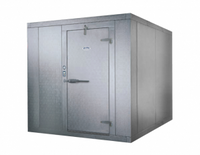
Ice buildup can be a huge problem when it comes to efficiently operating your walk-in freezer. Icing can also affect the freshness of food due to excess water and humidity being present in your walk-in.
Following these simple concepts can help you recognize, fix, and prevent icing issues before they cause major problems for your business:
UNDERSTAND WHY ICING HAPPENS
The presence of warm, humid air in your walk-in is the most likely reason for ice build up issues. Your walk-in door may not be sealing properly because of old or damaged gaskets. Without a proper seal, outside air can enter your freezer and cause problems. Other reasons your door may not be closing correctly include faulty hinges and problematic door closers. Make sure that employees aren’t accidently leaving freezer doors open when restocking items. This lets large amounts of warm air inside that can contribute to icing problems.
If you notice ice build up around your evaporator coil, your freezer may be experiencing a fan delay relay failure. This is something an experienced technician can diagnose and repair. Ice can also develop near your drain if your drain line becomes clogged. Clogs cause water to pool and freeze over time.
Finally, insulation panels can begin to accumulate ice inside of them as they grow older. If your freezer is over 10 years old your panels may no longer be efficient in insulating your freezer. Not only does this increase utility costs but can also cause icing problems inside the freezer storage area.
THE DAMAGE ICING CAN CAUSE
As mentioned above, the items and products stored in your freezer can be easily damaged by ice buildup. In addition, melting and refreezing ice can cause water to enter the inside of your freezer, potentially damaging its interior components. Evaporator fans are especially susceptible to icing problems. If ice is allowed to accumulate for extended periods of time, fan blades can be damaged by hitting the ice over and over again.
Icing doesn’t only cause physical damage; it can also greatly increase the operating costs of running your walk-in freezer. When the interior components of your walk-in have to compete with excess humidity and warm air they have to work harder to maintain temperature levels. This causes them to use more energy, driving your utility bill up. In addition, repairs from ice damage can become costly, especially if multiple components are affected.
HOW TO PREVENT ICING PROBLEMS
The first step to preventing ice build up is to regularly check gaskets, door hardware, drains, as well as insulation panels and repair them as necessary. You can also install air curtains or vinyl strip curtains to stop the infiltration of humid, warm air into your walk-in as individuals move in and out of it. Another great way to avoid costly icing repairs and utility bills is to regularly run a defrost cycle for a sufficient amount of time.
We suggest following routine maintenance recommendations to keep your walk-in freezer running efficiently. Icing problems are common but preventative maintenance can keep ice build up at bay so that your costs stay low.
